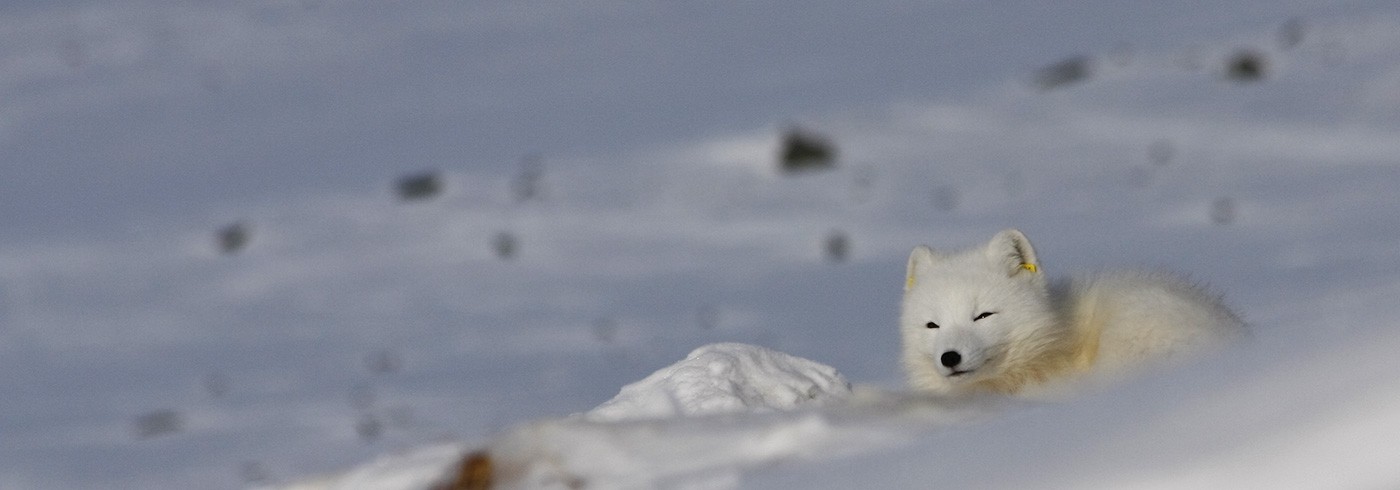Arctic Sweden – the arctic fox project
1 December 2008 - 1 September 2009
An 11-month-old female arctic fox. She was ear-tagged in 2008 during the Arctic Sweden expedition. Photo: Tomas Meijer
The Swedish mountain range became included in the SWEDARCTIC research programme during the International Polar Year 2007–2008 (IPY). Although the Swedish mountain range is considered as a southern offshoot from the Arctic, the sub arctic ecosystem bears many similarities to other arctic ecosystems. The annual fluctuations of lemmings (Lemmus and Dicrostonyx) and other small rodent are typical for most Arctic ecosystems. In order to understand these large fluctuations and their impact on the ecosystem, it is necessary to conduct long-term studies at the same sites. The Swedish mountain range facilitates a suitable area for such study, since it is possible to conduct fieldwork all year around and continuously return to the same sites. The arctic fox project focuses on how different predatorprey relationships affect the abundance of species, encompassing interactions between prey species (e.g. lemmings) and predators (e.g. arctic foxes, vulpes lagopus and red foxes, vulpes vulpes) but also interactions between the predators.
In order to study such interaction, large-scale inventories of both predator and prey abundance are performed during both winter and summer. Approximately 75% of all arctic fox cubs are captured and equipped with ear-tags and passive ID-markers for later identification. It is then possible to study survival and behaviour throughout the different phases of the lemming cycle by tracing the marked individuals. During the field season 2009, we conducted fieldwork in Helagsfjällen (Jämtland), Borgafjäll (Jämtland/Västerbotten) and Vindelfjällen (Västerbotten).
Fieldwork
Remote cameras are used to document visits to arctic fox dens enabling us to study survival of juvenile tagged arctic foxes as well as recording the presence of different predators, such as arctic fox, red fox, wolverine and golden eagle. The field season of 2009 started in December 2008 with collection of remote cameras that had been set out in late September during the expedition Arctic Sweden. Conducting fieldwork in December is complicated due to limited hours of daylight and with no sunlight reaching over the mountain peaks. However, during days with clear skies and moonlight, work can safely be conducted round the clock. Although the mountain tundra is covered by snow in December, the early winter landscape is very similar to the summer landscape with its many small hills and ravines. Later in the winter season, the ravines fill with more snow, smoothing out the landscape and thereby making it easier to travel in. Already in December, it was clear that the lemming and small rodent abundance was low, and this factor was characteristic for the rest of the field season. Despite low abundance of small rodents, more than 40 den sites with arctic foxes were found during the inventories in April. All these den sites were then revisited in July to study the breeding success, which clearly ref lected the low availability of prey, with only two confirmed arctic fox litters in Sweden during 2009. Of these two litters with a total of five cubs, only one cub survived the summer and was observed in late September. The lemming and small rodent abundance was very low in July but started to increase during late summer and autumn. This indicates a possible increase in the number of lemmings and small rodents for the 2010 season. The abundance of other prey species, such as ptarmigan, was also found to be low during the summer, which may be attributable to a high predation pressure due to the low abundance of lemmings.
The data from 2009 will be combined with data from both previous and upcoming years to give a more comprehensive understanding of the ecosystem. However, the field year 2009 typically ref lects a bottom year in the mountain tundra with a low abundance of prey species and migratory predators



